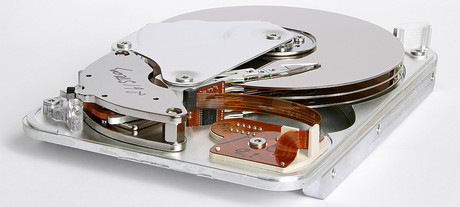Research promises disks with 100x storage

A new way of storing information on computer disks has been developed by University of Sydney researchers.
Instead of using a magnetic storage medium, the technique uses an electron beam working within an omnidirectional electric field to store bits on a special ceramic surface.
The process has the potential to store 100 times as much information in the same amount of storage medium.
The researchers also hope their work will lead to more environmentally friendly computer storage.
“The project focused on the materials science for memory storage. In some oxide ceramics called ferroelectric materials, there exist tiny domains that can that contain an electric dipole that is switchable,” said Zibin Chen, a PhD candidate at the university’s Faculty of Engineering and Information Technologies.
“Two opposite dipole directions can be used as the two logic signals ‘0’ and ‘1’, so that they can serve as memory bits.
Chen said the key challenge is how to ‘set’ the domains to one condition or the other, and how to ‘switch’ the domains once written. Conventional techniques use local heating, mechanical stress or electrical bias — all of which have major drawbacks.
“We have discovered that a high-energy electron beam with an omnidirectional electric field does the job,” Chen said.
“We are proposing an approach that could reduce the current domain size by 100 times, resulting in a 100 times greater data storage capability.
“This new materials science creates a roadmap that can be used by industry to create a next generation of better, greener, more stable computer memory,” said Chen.
The PhD research was co-supervised by Professors Xiaozhou Liao and Simon Ringer from the Faculty of Engineering and Information Technologies, whose work is part of the faculty’s Materials and Structures Research Group.
“The most notorious cause of failure for computer hard drives is a head crash, where the ‘head’ of the device that hovers just above the rotating disk touches or scratches the data-storage platter surface,” said Professor Liao. “A head crash usually incurs severe data loss.
“Our approach requires no physical contact of a tip or any other manipulator with the data storage media and therefore avoids possible physical damage to the devices,” he added.
“As materials engineers, we think a lot about how to stimulate local changes in the atomic-scale structure of materials so as to access remarkable new properties and behaviour,” said Professor Ringer.
“We are really excited to have discovered that applying these local electric fields with nanoscale precision can create a new paradigm for computer memory.”
Seven predictions that will shape this year
Pete Murray, Managing Director ANZ for Veritas Technologies, predicts trends that will have a...
ARENA jointly funds Vic's first large-scale battery storage
Two large-scale, grid-connected batteries are to be built in Victoria with the help of the...
Protecting next-gen storage infrastructures
Companies looking to modernise their overall IT infrastructure cannot afford to take a relaxed...




